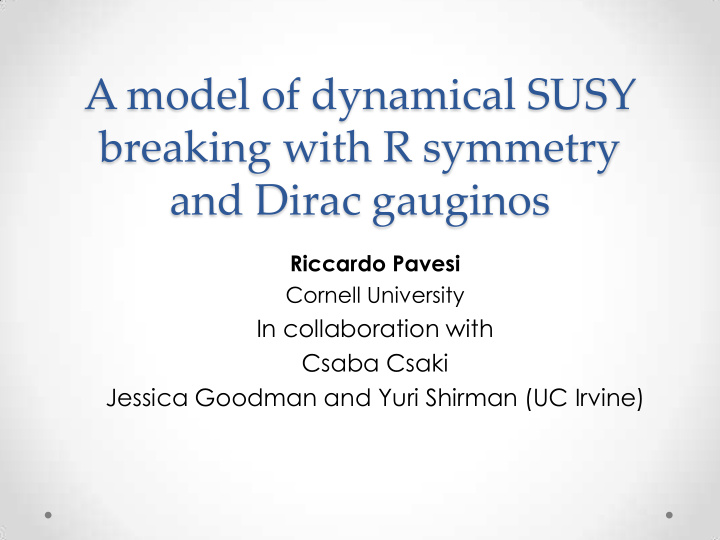



A model of dynamical SUSY breaking with R symmetry and Dirac gauginos Riccardo Pavesi Cornell University In collaboration with Csaba Csaki Jessica Goodman and Yuri Shirman (UC Irvine)
Motivation for R symmetry • Dirac masses: MSSM: top/stop loop in Higgs mass log-divergent hence: Naturalness→low scale stops BUT Dirac gluino mass cuts off the divergence, it allows heavier superpartners (1 TeV) • Heavy gluino (5 TeV) production is kinematically suppressed • Naturally squarks lighter than gluinos • R symmetry: Takes care of FCNC and CP-violation, relevant interactions are absent (Kribs et al., hep-ph: 0712.2039 )
Collider phenomenology Kribs,Martin, hep-ph: 1203.4821 • T-channel gluino exchange is forbidden (same handedness) or 2 (mixed) suppressed by 𝑁 3 Only relevant squark production channels
Supersoft mediation Fox, Nelson, Weiner (hep-ph/0206096) 𝛽 𝑁 𝑘 ′ 𝑋 𝑋 𝛽 • 𝑒 2 𝜄 𝑘 Λ W’: U(1)’ gauge. Wj: SM gauge field; Mj: adjoint chiral superfield: gaugino partners Need the D’ term from a U(1)’ gauge field • 𝐸 ′ Λ 𝜇 𝑘 𝑛 𝑘 Contains Dirac mass term: • Generates FINITE sfermion masses, gauge loops • Can generate this operator from messengers • 𝜚 + 𝜚 𝑁𝜚 𝑒 2 𝜄 𝑛𝜚
Seiberg duality and modifying ISS The s- confining low energy dual of SUSY QCD with 6 flavors • Flavor group SU(6) broken by gauging SU(5) subgroup and • identifying with the SM Theory of Baryons and Mesons • 𝑘 𝑂 𝑘 𝜚 𝑘 𝑁 𝑗 = 𝑁 B = 𝜔 𝑂 𝑗 𝑌 𝑁 𝐶 = 𝝔 𝑵𝝔 + 𝜔𝑂𝜚 + 𝜔 𝑂 𝜚 + 𝜔𝜔 𝑌 • Seiberg → 𝑋 = 𝐶 • M adjoint is partnered to SM gauginos, automatic trilinear term
Additional Superpotential From Seiberg Meson 𝒀 − 𝝂 𝟑 𝒀 + • 𝝎𝝎 + 𝑼 𝝎 + 𝜷𝒂𝑼𝑼 + 𝒊𝑻 𝝎 + 𝑼 + 𝒊′𝑻 Baryon Baryon 𝑈, 𝑈 , 𝑎 • Singlets 𝑇, 𝑇, • Can Gauge U(1) B Baryon number • Consistent with U(1) R R-symmetry • The additional terms force asymmetric VEV’s → D term
Minimum and VEV’s 𝒙𝒋𝒖𝒊𝒋𝒐 𝒄𝒃𝒔𝒛𝒑𝒐𝒕 & 𝑼, 𝑼 get VEV’s • 𝝎, 𝝎 • TrM is given VEV by hand with additional singlet. This also provides φ masses • Couplings h and h’ are irrelevant in the “Electric theory”, some tuning required. Can be chosen equal and then Charge Conjugation is broken spontaneously→ D term • There is NO flat direction • M adjoint remains massless
Mediation (loops) Dirac gaugino mass: • Scalar M masses: • 𝟑 𝜺 𝟑 Sfermion soft masses, 𝒏 𝟑 = 𝑫 𝒋 (𝒔)𝜷 𝒋 𝒏 𝒋 𝟑 ) 𝐦𝐩𝐡 ( • 𝝆 𝒏 𝒋 δ is the mass of scalar M
Scales • Require tuned coincidence coupling of 𝑻 𝝎 ≈ 𝑻 𝑼 • Spectrum much dependent on parameters • Example: • 𝜈 2 = Λ 𝑛 𝐹𝑚𝑓𝑑𝑢𝑠𝑗𝑑 ~(5000 𝑈𝑓𝑊) 2 3 • ℎ ≅ ℎ ′ = Λ Λ~10,000 𝑈𝑓𝑊 𝑁 𝑉𝑊 • Λ 𝑏𝑡 ℎ𝑗ℎ 𝑏𝑡 10 15 𝐻𝑓𝑊 • Gluino ~ 5 TeV • Scalar M adjoint ~ 50 TeV • Squarks ~ 800 Gev − 1 TeV
Conclusions • It was possible to construct a model of SUSY breaking that produces both D and F terms • An R symmetry is unbroken which allows evading collider bounds and flavor bounds • Dirac gaugino masses are naturally heavier and partners can be automatically obtained from mesons in a confining SQCD theory • Interesting phenomenologies are now within reach of model-builders • The Higgs sector is work for the future
Higgs • R symmetry forbids having both μ and B μ together • In original Fox, Nelson, Weiner quartic is suppressed but NOT here, due to large mass for scalar Adj M • Possible to introduce fields with R-charge 2: o 𝑋 = 𝜈 𝑣 𝐼 𝑣 𝑆 𝑣 + 𝜈 𝑒 𝐼 𝑒 𝑆 𝑒 • Not clear how to generate this within our mediation →Need direct coupling • Can use standard mechanisms for generating B μ
Recommend
More recommend